February 19th, 2016 § § permalink

The cast of Hamilton accepting the Grammy for best cast recording (Photo by Howard Sherman)
I guess my dash from row O to row A the other night pretty much erased any pretence of professional distance. Especially once Entertainment Weekly magazine saw fit to write about it.
My so-called sprint was occasioned by my attendance at Monday night’s live broadcast of the opening number from the musical Hamilton, which was being performed at its home at the Richard Rodgers Theatre in New York as part of the recording industry’s annual Grammy Awards. My seating shift was in response to a request for someone to fill an empty front row seat. I was happy to help out, and I received a round of applause for my selflessness.
Online, my efforts prompted a number of Twitter followers and Facebook friends to call me a “fanboy”, and while it’s not a term I’d apply to myself in middle age, there are worse things that could be said of me. Since I have always maintained that I am not a critic, seeing myself as someone of the theatre who sometimes writes about the theatre, I’m actually a bit reassured to find that my fandom is showing. Thirty-six years after I first went to work in a box office, there’s something rejuvenating about finding that I am indeed still an enthusiastic fan of theatre, although a long way from starstruck.
Hamilton has certainly been the most public expression of my fandom, as evidenced by the 48 Ham4Ham videos that I’ve shot on the street outside the Rodgers, having begun them simply as material for a blog post I wrote in August, and never stopped. Just this week, my cover story on the musical’s protean creator and star, Lin-Manuel Miranda, comes out in Dramatics magazine, the only national US publication for high school theatre students. But I am not without self-control: I’ve seen Hamilton only twice, and I’ve never entered the ticket lottery for day-of-show seats.
By the standards of die-hards, I am an amateur. I have not committed the Hamilton cast recording to memory, like many fans who have yet to even see the show. While I would like to see it again at some point, I am not given to seeing shows numerous times; barring professional commitments, I rarely see any show more than twice, unlike fans I know and read of who happily see the same show dozens of times. My theatre fandom drives me to predominantly see that which I have not seen before. So little time, and so many shows.
As it happens, my front row experience, which also included witnessing Hamilton win the Grammy for best cast recording and a rapped acceptance by Lin-Manuel, came only four days after my latest opportunity to see perhaps my favourite stage performer work his magic once again. Bill Irwin, a gifted actor, clown, mime and so many other things, has returned to New York’s Signature Theatre with his sometime partner David Shiner for a second run of Old Hats, perhaps the 10th or 11th time I’ve seen Bill in a show of his own singular creation. I have been an unabashed fan of Bill’s since I first saw him in the mid-1980s; his particular gifts have the effect of making me grin the moment he walks on a stage (save for his career-changing turns in Albee’s The Goat and Virginia Woolf). Privileged to have first met him 15 years ago, when I greeted him excitedly by ticking off the litany of his work that I’d seen, like Kathy Bates in Misery, I take unbridled joy in seeing him at work – and now going backstage to see him along with an always intriguing mix of acting and circus royalty. I have long been a proselytiser to the cult of Bill, and I’m not in the least ashamed of it or subtle about it.
I think there’s something to be said for maintaining the enthusiasm of a fan even as the realities of raising money, balancing budgets, serving and collaborating with artists and staff, and so on, can abstract and distract from the very reason that drew us to work in the theatre in the first place. Given my career, I’m no longer the teen who stood in awe as James Earl Jones signed a programme for me, but I am also far from a jaded aesthete who deploys 35 years of theatregoing to decry the theatre of today. If you spot me by a stage door awaiting an audience with Laura Benanti or Audra McDonald, or at an event with camera phone at the ready (the better to feed my social media activity), don’t think less of me. After all, I’m still in touch with the kid who fell hard for theatre and never wanted to do anything else, and can still be thrilled by it and the people who make it.
Theatre needs fans not just in the seats, but in its offices, its rehearsal rooms and on its stages as well. After all, it’s not as if we’re in it for the money.
This essay originally appeared in The Stage.
December 3rd, 2015 § § permalink
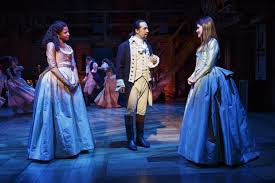
Renée Elise Goldsberry, Lin-Manuel Miranda and Phillipa Soo in Hamilton (Photo by Joan Marcus)
In the wake of the recent casting controversies over Katori Hall’s The Mountaintop and Lloyd Suh’s Jesus in India, there have been a number of online commenters who have cited Lin-Manuel Miranda’s musical Hamilton as a justification for their position in the debate. What’s intriguing is that Hamilton has been offered up both as evidence of why actors of color must have the opportunity to play both characters or color and characters not necessarily written as characters of color – but it has also been used to say that anything goes, and white actors should be able to play characters of color as well.
In the Broadway production of Hamilton, the characters are historical figures who were all known to have been white, but they are played by actors of many races and ethnicities, notably black, Latino and Asian. My position on non-traditional (or color-blind or color-specific) casting is that it is not a “two-way street,” and that the goal is to create more opportunities for actors of color, not to give white actors the chance to play characters of color.
As it happens, I had an interview scheduled with Miranda last week, the night before Thanksgiving. Race wasn’t the subject at all, however. We were speaking about his experiences in, and views on, high school theatre, for Dramatics magazine, a publication of the Educational Theatre Association (ask a high school thespian for a copy). But when I finished the main interview, and had shut off my voice recorder, I asked Miranda if he would be willing to make any comment regarding the recent casting situations that had come to light. He was familiar with The Mountaintop case, but I had to give him an exceptionally brief précis of what had occurred with Jesus in India. He said he would absolutely speak to the issue, and I had to hold up my hand to briefly pause him as he rushed to start speaking, while I started recording again.
“My answer is: authorial intent wins. Period,” Miranda said. “As a Dramatists Guild Council member, I will tell you this. As an artist and as a human I will tell you this. Authorial intent wins. Katori Hall never intended for a Caucasian Martin Luther King. That’s the end of the discussion. In every case, the intent of the author always wins. If the author has specified the ethnicity of the part, that wins.
“Frankly, this is why it’s so important to me, we’re one of the last entertainment mediums that has that power. You go to Hollywood, you sell a script, they do whatever and your name is still on it. What we protect at the Dramatists Guild is the author’s power over their words and what happens with them. It’s very cut and dry.”
This wasn’t the first time Miranda and I have discussed racial casting. Last year, we corresponded about it in regard to high school productions of his musical In The Heights, and his position on the show being done by high schools without a significant Latino student body, which he differentiated from even college productions.
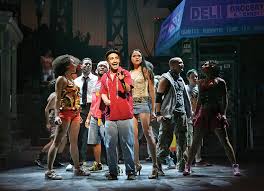
Lin-Manuel Miranda, Karen Olivo and the company of In The Heights (Photo by Joan Marcus)
“The joy of In The Heights runs both ways to me,” he wrote me in early 2014. “When I see a school production with not a lot of Latino students doing it, I know they’re learning things about Latino culture that go beyond what they’re fed in the media every day. They HAVE to learn those things to play their parts correctly. And when I see a school with a huge Latino population do Heights, I feel a surge of pride that the students get to perform something that may have a sliver of resonance in their daily lives. Just please God, tell them that tanning and bad 50’s style Shark makeup isn’t necessary. Latinos come in every color of the rainbow, thanks very much.
“And I’ve said this a million times, but it bears repeating: high school’s the ONE CHANCE YOU GET, as an actor, to play any role you want, before the world tells you what ‘type’ you are. The audience is going to suspend disbelief: they’re there to see their kids, whom they already love, in a play. Honor that sacred time as educators, and use it change their lives. You’ll be glad you did.”
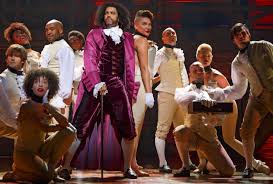
Daveed Diggs and the company of Hamilton (Photo by Joan Marcus)
Anticipating the flood of interest in producing Hamilton once the Broadway production and national tours have run their courses, I asked Miranda whether the acting edition of the script of Hamilton will ultimately be specific about the cast’s diversity, and whether, either at the college level or the professional level, he would foresee a situation where white actors were playing leading roles.
“I don’t have the answer to that. I have to consult with the bookwriter, who is also me,” he responded. “I’m going to know the answer a little better once we set up these tours and once we set up the London run. I think the London cast is also going to look like our cast looks now, it’s going to be as diverse as our cast is now, but there are going to be even more opportunities for southeast Asian and Asian and communities of color within Europe that should be represented on stage in that level of production.
“So I have some time on that language and I will find the right language to make sure that the beautiful thing that people love about our show and allows them identification with the show is preserved when this goes out into the world.”
Authorial intent, y’all. Authorial intent.
Howard Sherman is interim director of the Alliance for Inclusion in the Arts and director of the Arts Integrity Initiative at The New School College of Performing Arts.
October 14th, 2014 § § permalink
Aside from being the month of copious pumpkin flavored foodstuffs, October also brings two perennial theatrical top ten lists that are worthy of note: American Theatre magazine’s list of the most produced plays in Theatre Communications Group theatres for the coming season and Dramatics magazine’s lists of the most produced plays, musicals and one-acts in high school theatre for the prior year. They both say a great deal about the state of theatre in their respective spheres of production, both by what’s listed explicitly, as well as by what doesn’t appear.
In the broadest sense, both lists are startlingly predictable, although for different reasons. If you happen to find a bookie willing to give you odds on predicting the lists, here’s the trick for each: for the American Theatre list, bet heavily on plays which appeared on Broadway, or had acclaimed Off-Broadway runs, in the past year or two. For the Dramatics list, bet heavily on the plays that appeared on the prior year’s list.
But in the interest of learning, let’s unpack each list not quite so reductively.
American Theatre
 As I’ve written in the past, what happens in New York theatre is a superb predictor of what will happen in regional theatre in the coming seasons, especially when it comes to plays. Any play that makes it to Broadway, or gets a great New York Times review, is going to grab the attention of regional producers. Throw in Tony nominations, let alone a Tony win – or the Pulitzer – and those are the plays that will quickly crop up on regional theatre schedules.
As I’ve written in the past, what happens in New York theatre is a superb predictor of what will happen in regional theatre in the coming seasons, especially when it comes to plays. Any play that makes it to Broadway, or gets a great New York Times review, is going to grab the attention of regional producers. Throw in Tony nominations, let alone a Tony win – or the Pulitzer – and those are the plays that will quickly crop up on regional theatre schedules.
Anyone who follows the pattern of production would have easily guessed that Christopher Durang’s Vanya and Sonia and Masha and Spike would proliferate this year, being a thoughtful, literary based comedy with a cast of only six. That American Theatre lists 27 productions doesn’t even take into account the 11 theatres that did the show in 2013-14, and certainly there are non-TCG theatres which are doing the show as well. It’s no surprise that Durang has said he made more money this past year than in any other year of his career; it’s a shame that financial success has taken so long for such a prodigiously gifted writer and teacher.
In general, shows on the American Theatre list have about a three year stay, typically peaking in their second year on the list, but this can vary depending upon when titles are released by licensing houses and agents to regional theatres. 25 years ago (and more significantly years before that) theatres might have had to compete with commercial tours, but play tours are exceedingly rare birds these days, if not extinct.
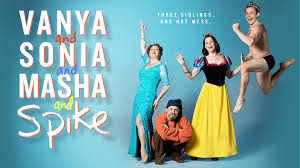 Perhaps this rush to the familiar and popular and NYC-annointed is disheartening, but it’s worth observing that the American Theatre list notes how many productions each title gets, and that after the first couple of slots, we’re usually looking at plays that are getting 7 or 8 productions in a given season, across TCG’s current universe of 474 member companies (404 of which were included in this year’s figures). Since the magazine notes a universe of 1,876 productions, suddenly 27 stagings of a single show doesn’t seem so dominant after all. Granted, TCG drops Shakespeare from their calculations, but even he only counted for 77 productions of all of his plays across this field. So reading between the lines, the American Theatre list suggests there’s very little unanimity about what’s done at TCG member theatres in any given year, a less quantifiable achievement but an important one.
Perhaps this rush to the familiar and popular and NYC-annointed is disheartening, but it’s worth observing that the American Theatre list notes how many productions each title gets, and that after the first couple of slots, we’re usually looking at plays that are getting 7 or 8 productions in a given season, across TCG’s current universe of 474 member companies (404 of which were included in this year’s figures). Since the magazine notes a universe of 1,876 productions, suddenly 27 stagings of a single show doesn’t seem so dominant after all. Granted, TCG drops Shakespeare from their calculations, but even he only counted for 77 productions of all of his plays across this field. So reading between the lines, the American Theatre list suggests there’s very little unanimity about what’s done at TCG member theatres in any given year, a less quantifiable achievement but an important one.
Dramatics
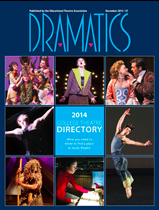 While titles come and go on the American Theatre list, stasis is the best word to describe the lists of most produced high school plays (it’s somewhat less true for musicals). Nine of the plays on the 2014 list were on the 2013 list; 2014 was topped by John Cariani’s Almost, Maine, followed by A Midsummer Night’s Dream and the two titles were in reverse order the prior year. The other duplicated titles were Our Town, 12 Angry Men (Jurors), You Can’t Take It With You, Romeo and Juliet, The Crucible, Harvey and The Importance of Being Earnest.
While titles come and go on the American Theatre list, stasis is the best word to describe the lists of most produced high school plays (it’s somewhat less true for musicals). Nine of the plays on the 2014 list were on the 2013 list; 2014 was topped by John Cariani’s Almost, Maine, followed by A Midsummer Night’s Dream and the two titles were in reverse order the prior year. The other duplicated titles were Our Town, 12 Angry Men (Jurors), You Can’t Take It With You, Romeo and Juliet, The Crucible, Harvey and The Importance of Being Earnest.
Like the American Theatre list, the Dramatics survey doesn’t cover the entirety of high school theatre production; only those schools that are members of the Educational Theatre Association’s International Thespian Society have the opportunity to participate, representing more than 4,000 high schools out of a universe of 28,500 public, private and parochial secondary schools in the country. Unlike the Dramatics list, there are no hard numbers about how many productions each show receives, so one can only judge relative popularity.
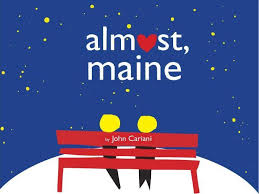 Almost, Maine’s swift ascension to the top rungs of the list is extraordinary, but it’s due in no small part to its construction as a series of thematically linked scenes, originally played by just four actors but easily expandable for casts where actor salaries aren’t an issue. Looking at recent American Theatre lists, they tend to be topped by plays with small casts (Venus in Fur, Red, Good People and The 39 Steps), while the Dramatics list is the reverse, with larger cast plays dominating, in order to be inclusive of more students (though paling next to musicals where casts in school shows might expand to 50 or more).
Almost, Maine’s swift ascension to the top rungs of the list is extraordinary, but it’s due in no small part to its construction as a series of thematically linked scenes, originally played by just four actors but easily expandable for casts where actor salaries aren’t an issue. Looking at recent American Theatre lists, they tend to be topped by plays with small casts (Venus in Fur, Red, Good People and The 39 Steps), while the Dramatics list is the reverse, with larger cast plays dominating, in order to be inclusive of more students (though paling next to musicals where casts in school shows might expand to 50 or more).
The most important trend on the Dramatics list (which has been produced since 1938) is the lack of trends. Though a full assessment of the history of top high school plays would take considerable effort, it’s worth noting that Our Town was on the list not only in 2014 and 2013, but also in 2009, 1999 and 1989; the same is true for You Can’t Take It With You. Other frequently appearing titles are Arsenic and Old Lace, various adaptations of Alice in Wonderland, Harvey, and The Miracle Worker.
No doubt the lack of newer plays with large casts is a significant reason why older classic tend to rule this list; certainly the classic nature of these works and their relative lack of controversial elements play into it as well. But as I watched Sheri Wilner’s play Kingdom City at the La Jolla Playhouse a few weeks ago, in which a drama director is compelled to choose a play from the Dramatics list, I wondered: is the list self-perpetuating? Are there numerous schools that seek what’s mainstream and accepted at other schools, and so do the same plays propagate themselves because administrators see the Dramatics list as having an implied educational seal of approval?
That may well be, and if it’s true, it’s an unfortunate side effect of a quantitative survey. But it’s also worth noting that many of these plays, vintage though they may be, have common themes, chief among them exhortations to march to your own drummer, to matter how out of step you may be to the conventional wisdom. They may be artistic expressions from other eras about the importance of individuality, but in the hands of teachers thinking about more than just placating parents, they are also opportunities to celebrate those among us who may seem different or unique, and for fighting for what you believe in against prevailing sentiment or structures.
* * *
Looking at musicals on the American Theatre list is a challenge, because their list is an aggregate of plays and musicals, and while many regional companies now do a musical or two, it’s much harder for any groundswell to emerge. In the last five years, only three musicals have made it onto the TCG lists, each for one year only: Into The Woods, Spring Awakening and The 25th Annual Putnam County Spelling Bee. That doesn’t mean there’s a dearth of musical production, it simply shows that the work is being done by companies outside of the TCG universe.
 Musicals are of course a staple of high school theatre, but the top ten lists from Dramatics are somewhat more fluid. While staples like Guys and Dolls, Grease, Once Upon a Mattress, You’re A Good Man Charlie Brown and Little Shop of Horrors maintain their presence, newer musicals arrive every year or two, with works like Seussical, Legally Blonde, Spelling Bee, and Thoroughly Modern Millie appearing frequently in recent years. At the peak spot, after a six-year run, Beauty and the Beast was bested this year by Shrek; as with professional companies, when popular new works are released into the market, they quickly rise to the top. How long they’ll stay is anyone’s guess, but I have little doubt that we’ll one day see Aladdin and Wicked settle in for long tenures.
Musicals are of course a staple of high school theatre, but the top ten lists from Dramatics are somewhat more fluid. While staples like Guys and Dolls, Grease, Once Upon a Mattress, You’re A Good Man Charlie Brown and Little Shop of Horrors maintain their presence, newer musicals arrive every year or two, with works like Seussical, Legally Blonde, Spelling Bee, and Thoroughly Modern Millie appearing frequently in recent years. At the peak spot, after a six-year run, Beauty and the Beast was bested this year by Shrek; as with professional companies, when popular new works are released into the market, they quickly rise to the top. How long they’ll stay is anyone’s guess, but I have little doubt that we’ll one day see Aladdin and Wicked settle in for long tenures.
* * *
When I looked at both the American Theatre and Dramatics lists over a span of time, the distinct predictability of each was troubling. Coming out when they do, before most theatrical production for the next theatre season is set, I’d like to see them looked at not as any manner of affirmation, but as a challenge – whether to professional companies or school schedules. I admire and enjoy the plays that are listed here, and nothing herein should be construed as critical of any of these shows; audiences around the country deserve the opportunity to see them. While I do have the benefit of living in New York and seeing most of these popular shows there, I must confess that I am most intrigued by the theatre companies and school groups that might just say to themselves, ‘Let’s not do the shows, or too many of the shows, that appear on these lists. Let’s find something else.’ Those plays may never appear as part of any aggregation, but I suspect the groups’ work will be all the more interesting for it, benefiting both artists and audiences.












